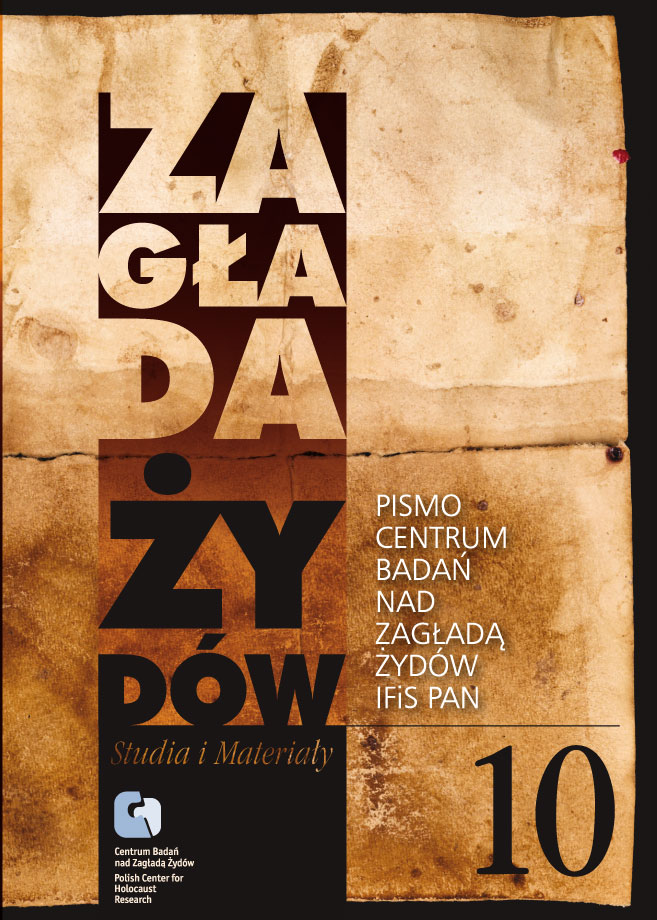Krzesiny i Kreising – między pamiętaniem a pomijaniem. Polskie miasteczko wobec historii, pamięci i rywalizacji w cierpieniu
Zagłada Żydów. Studia i Materiały, Nr 10 (2014), Strony: 443-461
Data zgłoszenia: 2020-10-22Data publikacji: 2014-12-01
 https://doi.org/10.32927/ZZSiM.532
https://doi.org/10.32927/ZZSiM.532
Abstrakt
The area around Krzesiny, located near the city of Poznań, Poland, witnessed several dark events during World War II: Germans oppressed the local population, culminating in a terrorizing action dubbed “akcja krzesińska;” also, a forced labor camp, named “Kreising,” was built near the township, housing mainly Jews. After the war, the suffering in Krzesiny was remembered, but selectively – “akcja” and other forms of Polish suffering were commemorated, while the camp was not. By exploring the “lieux de mémoire” in Krzesiny – dynamics of memory in a small township in Poland – this paper uses localized research to address the issue of gaps in collective memory and commemoration. We briefly look at the relevant history, Polish memory regarding wartime events in Krzesiny, and the postwar dynamics of collective memory. Discussing the latter, we identify a new phenomenon at work, one which we dub “collective disregard” – group neglect of the past of the “Other” that occurs without clear intent. We argue that “collective disregard” is an issue that naturally occurs in the dynamics of memory. By making a deliberate investment in balanced remembrance and commemoration, societies can counter the tendencies of “disregard” and curb the controversies of competitive victimization claims, also called “competitive martyrdom”.
Licencja
Prawa autorskie (c) 2014 Autor & "Zagłada Żydów. Studia i Materiały"

Utwór dostępny jest na licencji Creative Commons Uznanie autorstwa 4.0 Międzynarodowe.
https://creativecommons.org/licenses/by/4.0
Podobne artykuły
- Ewa Teleżyńska-Sawicka, Noach Lasman, Wspomnienia z trzech światów , Zagłada Żydów. Studia i Materiały: Nr 16 (2020)
- Anna Szwarc-Zając , Willy, przyjaciel prawdziwy czy wymyślony? Rozważania nad polskim i włoskim tłumaczeniem książki Szukajcie w popiołach , Zagłada Żydów. Studia i Materiały: Nr 8 (2012)
- Galit Eilat, Nie dać zapomnieć , Zagłada Żydów. Studia i Materiały: Nr 17 (2021)
- Adam Kopciowski, Recenzja: Julian Kwiek, Nie chcemy Żydów u siebie. Przejawy wrogości wobec Żydów w latach 1944–1947, Warszawa: Wydawnictwo Nieoczywiste, 2021, 588 s. , Zagłada Żydów. Studia i Materiały: Nr 18 (2022)
- Jacek Leociak, Rocznice powstania w getcie warszawskim w dyskursie publicznym (ze szczególnym uwzględnieniem lat 1943–1944, 1968, 2023) , Zagłada Żydów. Studia i Materiały: Nr 19 (2023)
- Monika Polit, „O tym mógłby powiedzieć zastępca Starszego Gminy Żydowskiej Jakubowicz”. Postępowanie sądowe wobec Arona „Arka” Jakubowicza , Zagłada Żydów. Studia i Materiały: Nr 20 (2024)
- Daniel Logemann, Europejski wymiar Zagłady w książkach niemieckich historyków, czyli jak pisać o przemocy wobec Żydów wymierzonej nie przez Niemców , Zagłada Żydów. Studia i Materiały: Nr 14 (2018)
- Romuald Jakub Weksler-Waszkinel, Jak Pawłowski ukrywał Grinera [Sługa Mesjasza. Z ks. Grzegorzem Pawłowskim/Jakubem Herszem Grinerem rozmawia Lucyna Montusiewicz, Lublin, wyd. Gaudium 2005] , Zagłada Żydów. Studia i Materiały: Nr 1 (2005)
- Alina Skibinska, Dariusz Libionka, „Przysięgam walczyć o wolną i potężną Polskę, wykonywać rozkazy przełożonych, tak mi dopomóż Bóg”. Żydzi w AK. Epizod z Ostrowca Świętokrzyskiego , Zagłada Żydów. Studia i Materiały: Nr 4 (2008)
- Andrzej Żbikowski, Marcin Urynowicz, Adam Czerniaków 1880–1942. Prezes getta warszawskiego, Instytut Pamięci Narodowej, Warszawa 2009 , Zagłada Żydów. Studia i Materiały: Nr 6 (2010)
<< < 5 6 7 8 9 10 11 12 13 14 15 16 17 18 19 20 21 22 23 24 25 26 27 28 29 30 31 32 > >>
Możesz również Rozpocznij zaawansowane wyszukiwanie podobieństw dla tego artykułu.
 English
English
 Język Polski
Język Polski








